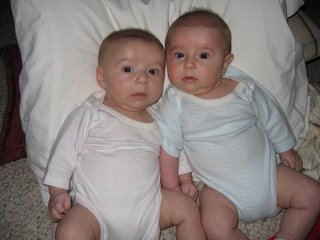Chemicals and Reproduction

Many (although not all) of my friends and family know that it was a difficult process for my wife Renee and I to get pregnant. Married in 1997, we assumed that we would wait a couple of years, and then start "trying" and if all went as planned (and we had no reason to suspect any reason why it would not), we would end up with a Y2K baby.
In 2000 we ceased using birth control and waited until the magical date when we would discover that Renee was pregnant. One year turned into two....which then turned into three. During this time, we did not heed the advice of one of my best friends (who is a leading fertility physician in Northern California) and begin exploring fertility treatments. Renee was told by her OB/GYN that she really shouldn't worry - that it wasn't that unusual for it to talk that long.
After three years of trying, we finally began the process of testing to discover what problems we may have physically that might be preventing Renee from becoming pregnant. I had my sperm count analyzed not once, not twice but three separate times to ensure that the results were consistent. (As an aside, for the amount of money fertility clinics charge their clients, you would think they could do better than have old adult movies recorded on a home VCR as your "inspiration"!!).
I was told that my sperm was literally not up to the task. It was lacking in both motility and mobility. That is, there weren't enough of the little guys and what those I did have were not great swimmers. So after consulting with my friend as well as a local fertility clinic, we opted to begin the IVF process. I will write about the complete IVF process separately, but for now I'll just note that it took us 3 cycles until we were able to conceive - and this ultimately led us to become parents of the 2 beautiful baby boys who are now peacefully sleeping (Stone and Ty) upstairs.
The reason I bring this all up is because a colleague sent me an article today with the headline, "Greenpeace report warns commonly found chemicals may be harming reproductive health." You can read the article here, but the part that really stood out for me was the following:
One 1992 study cited in the report showed that sperm count fell 50 percent between 1940 and 1990, while the incidence of testicular cancer progressively rose. Infertility today affects 15-20 percent of couples, compared with 7-8 percent in the early 1960s, the report said.
"On average, a typical Western man produces half the sperm his father or grandfather did," it said.
Many people have asked me where the idea for GreenforGood.com came from and why/how I've become so passionate about sustainability and the green lifestyle. While I've always tried to follow some of the most basic Green tenants (recycle, reuse, compost, etc.) it really wasn't until Renee and I went through this process and I started researching the potential causes behind our problems that I realized how much of a role our environment plays in our health. Call it ignorance (I sure do) but the fact is, we really do not hear or learn much about this from the mainstream media. And even if you do hear or read about it...there is a self-defense mechanism that kicks in (denial) that whispers in your ear, "it can't be THAT bad."
But since I have started sharing my story with family and friends, I've been absolutely shocked at how many of them have either personally experience fertility issues/problems or know another couple who has. The national figures state that officially 15-20% of couples have fertility problems in the US - but my hunch is that it's probably even higher.
So if and when you are asked why you don't want to use pesticides in your yard, or household cleaners that contain chemicals, or why you are replacing the old carpet with hardwood floors, you have one more reason why it pays to avoid chemicals.
David R. Kaufer
President and Chief Green Officer
GreenforGood.com
0 Comments:
Post a Comment
<< Home